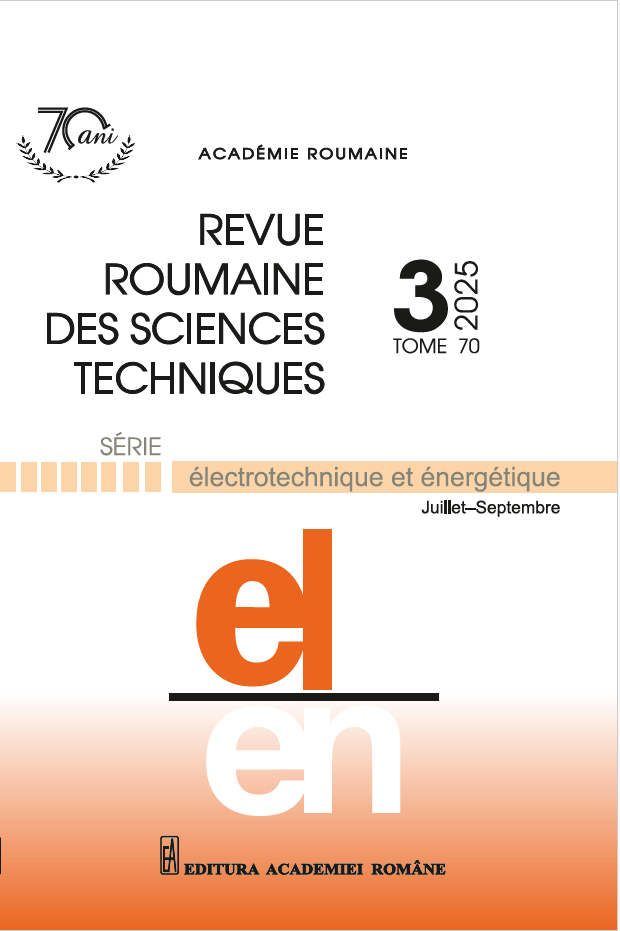FAULT-TOLERANT, CAPABLE, AND SCALABLE TWO-TIME-SCALE BOOST CONVERTER MEANT FOR RESIDENTIAL AREAS
DOI:
https://doi.org/10.59277/RRST-EE.2025.3.15Keywords:
Microgrids, Actual joint torque, Fault tolerance, High performance, Robust control, Electrical storage systems, Optimized efficiency, Scalable converterAbstract
The feasibility of next-generation urban power networks hinges on the ability of DC converters to replace their conventional counterpart. Reliability and efficiency are heavily contested points when discussing the challenges facing power electronics proliferation in power systems. Motivated to find a working solution, this paper presents the paradigm of the two-time scale converter. By employing a division in dynamics, interpreted from singular perturbation theory, a cost-effective redundancy can be attained in the form of complementary fast and slow subsystems. This enables the proposed converter to handle considerable perturbations with a quick response time and achieve cost-effective operation at steady state, thanks to the reduction in switching frequency. The overall controller scheme consists of an inner current control loop and an outer voltage control loop; the control laws are derived from a generic Lyapunov’s approach, which can be adapted to the characteristics of the voltage source. The simulation results demonstrated a seamless response to various types of perturbations and the proper handling of different omission fault scenarios.
References
(1) V. Vossos, D. L. Gerber, M. Gaillet-Tournier, B. Nordman, R. Brown, W. Bernal Heredia, S. M. Frank, Adoption pathways for DC power distribution in buildings, Energies, 15, 3, pp. 786 (2022).
(2) D. Santoro, N. Delmonte, M. Simonazzi, A. Toscani, N. Rocchi, G. Sozzi, R. Menozzi, Local power distribution—A review of nanogrid architectures, control strategies, and converters, Sustainability, 15, 3, pp. 2759 (2023).
(3) M. Najafzadeh, R. Ahmadiahangar, O. Husev, I. Roasto, T. Jalakas, A. Blinov, Recent contributions, future prospects and limitations of interlinking converter control in hybrid AC/DC microgrids, IEEE Access, 9, pp. 7960–7984 (2021).
(4) S. Chellappan, J. Rangaraju, Power topology considerations for solar string inverters and energy storage systems, Texas Instruments, SLLA498 – October (2020).
(5) D. Kolantla, S. Mikkili, S. R. Pendem, A. A. Desai, Critical review on various inverter topologies for PV system architectures, IET Renew. Power Gener., 14, no. –, pp. 3418–3438 (2020).
(6) A.C. Zambroni de Souza, M. Castilla, Microgrids design and implementation, Springer, ISBN: 978-3-319-986869 (2019).
(7) B. Hadmer, S. Drid, A. Kouzou, L. Chrifi-Alaoui, Voltage sensorless control of five-level packed U-cell inverter based on Lyapunov approach for grid-connected photovoltaic system, Rev. Roum. Sci. Techn. – Électrotechn. Et Énerg., 69, 2, pp. 135–140 (2024).
(8) S. Latreche, B. Babes, A. Bouafassa, Design and real-time implementation of synergetic regulator for a DC-DC boost converter, Rev. Roum. Sci. Techn. – Électrotechn. Et Énerg., 69, 3, pp. 305–310 (2024).
(9) R. Thankakan, N. A. Edward-Rajan-Samuel, A novel power converter fed by photovoltaic source employing improved incremental conductance algorithm under partial shadow conditions, Rev. Roum. Sci. Techn. – Électrotechn. Et Énerg., 67, 2, pp. 145–150 (2022).
(10) A. Benaissa, B. Rabhi, M.F. Benkhoris, L. Zellouma, Linear quadratic controller for two-interleaved boost converter associated with PEMFC emulator, Rev. Roum. Sci. Techn. – Électrotechn. Et Énerg., 66, 2, pp. 125–130 (2021).
(11) A.E. Ahmed, M. Zohdy, Sliding mode control for singularly perturbed systems using accurate reduced model, Int. J. Mod. Nonlinear Theory Appl., 10, 1, pp. 1 (2021).
(12) S. Hebertt, S. Ramón, Control design techniques in power electronics devices, Cinvestav-IPN, Departamento de Ingeniería Eléctrica, Sección de Mecatrónica, Power Systems Series, pp. 20–81 (2006).
(13) H. Sira-Ramírez, R. Silva-Ortigoza, Control design techniques in power electronics devices, Springer, 5, pp. 23–63 (2006).
(14) W. Li, J.-J. E. Slotine, Applied nonlinear control, Prentice-Hall, Inc., pp. 276–307, ISBN: 0-13-040890-5 (1990).
(15) J. Guldner, J. Shi, V. Utkin, Sliding mode control in electro-mechanical systems, Taylor & Francis, pp. 232 (1999).
(16) T. Sari, Singular perturbation methods in control theory, Mulhouse University, Nice University (2006).
(17) C. Gschwendtner, C. Knoeri, A. Stephan, The impact of plug-in behavior on the spatial–temporal flexibility of electric vehicle charging load, Sustainable Cities and Society, 88, pp. 104263 (2023).
(18) M.-D. Drid, S. Hamdani, A. Nait-Seghir, L. Chrifi-Alaoui, S. Labdai, S. Drid, Optimal energy management systems and voltage stabilization of renewable energy networks, Applied Sciences, 14, 21, pp. 1–22 (2024).
Downloads
Published
Issue
Section
License
Copyright (c) 2025 REVUE ROUMAINE DES SCIENCES TECHNIQUES — SÉRIE ÉLECTROTECHNIQUE ET ÉNERGÉTIQUE

This work is licensed under a Creative Commons Attribution-NonCommercial-NoDerivatives 4.0 International License.


